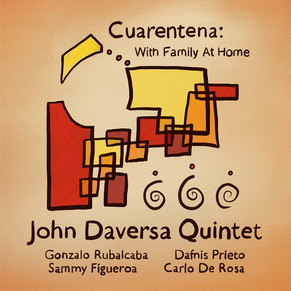
In Daversa’s eighth album, Cuarantena: With the Family at Home, takes the opportunity for imagining and reimagining love of friends and family and the things that draw us together—especially music. Good music like the bolero.
In meditations on that idea, Daversa drew together some of Miami’s most sought-after artists, such as pianist Gonzalo Rubalcaba, Carlo De Rosa on bass, drummer Dafnis Prieto, and Sammy Figueroa on percussion. Daversa, of course, is the man behind the trumpet.
The whole idea of the album was developed in conversations between Daversa and Rubalcaba centering on the bolero and its centrality in familial music. The bolero style—not to be confused with the composition by Maurica Ravel—is a Cuban style that features moderate to slow times with a repeating rhythm over which those beautiful melodies are laid. It became fused with other forms like the Son, Mambo, Chachacha, and Danzón. Leonardo Acosta called bolero the first great Cuban vocal/musical synthesis to achieve worldwide attention. This is the music that united their families.
The album opens with #45, a tune written on a melody composed by Daversa’s father, the great trumpet player, Jay Daversa. Daversa confesses that his father never wrote titles for any of his compositions, just numbers. It is a beautiful melody that evokes visions of a family in tender fellowship with one another. Rubalcaba’s piano is equally tender before the trumpet spells out the affection. The trading between Daversa’s muted trumpet and Rubalcaba’s piano is brilliant—lively, understanding, insightful—just like a conversation around the dinner table.
Another of the senior Daversa’s melodies follows with #22. It is a touching piece filled with emotion and reminiscence of loved ones. Beautiful trumpet and piano passages with an excellent rhythm section behind it all. DeRosa’s bass work is warm and fitting.
A spoken-word interlude from Daversa follows, as he speaks of Growing Up in a Musical Family. A wonderful reflection.
La Bailarina (para Tatiana) is for his wife who added dance into the family mode of expression. He mentions her in the previous spoken-word track. The music conjures images of a dancer gliding through life, thoughtfulness and grace in her wake. A lovely, lovely piece of music.
Oma (a la Madre Divina) is best translated as To the Divine Mother. That exquisite Latin chordal arrangement that calls on the universal, divine aspect of the feminine. The Cosmic Mother who comforts, nourishes, and protects her children and who has her place in every family and home. Steady percussion from Sammy Figueroa and steady, reliable piano from Rubalcaba are such fine foundations for Daversa’s trumpet.
Sammy Figueroa adds his own spoken-word interjection next and honors his father, famous bolero singer Charlie Figueroa. Sammy, who hails from Puerto Rico, accepted Daversa’s suggestion to play one of Charlie’s tunes and Sammy would give the percussion introduction to it. And so follows…
El Último Suspiro (The Last Sigh) is Charlie Figueroa’s piece that is indeed introduced by Sammy’s fine and respectful percussion introduction. Prieto’s drums and De Rosa’s bass are worth special attention as Daversa’s melodic trumpet carries all the memory and honor one would hope. Then go back and find Charlie’s version of the song.
Soldado Distinguido (para Sgt. Alvin York) honors Daversa’s grandmother, a relative of Alvin York, the most decorated American soldier of World War I. York never wanted to fight but chose to in order to save the lives of his comrades. The melody is peaceful and devoted. It is an honor to York and his grandmother.
Puppitas (para Lea y Maya) is an homage to the family pets, a song encouraged by his daughter. It is playful and teasing. Listen carefully to hear Lea’s panting on the track. Delightful.
Fabrica de Conservas de San Francisco (La Historia de Molly y Johnny) is a gorgeous piano and trumpet duet which tells the tales of his paternal grandparents, Molly and Johnny. Johnny wrote a hand-written book of memoirs which tells their story and which Daversa reads to his own daughter. Here, Daversa keeps the family’s tales fresh and vibrant and to be cherished by his and our own families—to remember the love of our parents for each other and for us.
Gonzala Rubalcaba gets his turn to talk about music and family next and sets up Daversa’s father’s tune, #19. It is a swinging, exciting piece that features some of the tightest work on the whole album while also giving way to beautiful melodies.
Drummer Dafnis Prieto gets his chance to speak, telling of his musical home and introducing Un Bolero para Lola, the song by Debi Nova, written for her own grandmother, Lola. It is beautiful and loving. Daversa’s trumpet covers Debi’s vocals beautifully and the whole Quintet turns in a lovely remembrance.
Bassist Carlo De Rosa speaks last and it is sweet and sad. De Rosa tells of his inability to visit his family because of the age of his parents. He speaks to them often but, for safety’s sake, cannot see them.
Opus 1 (escrita por El Abuelo Austin) is a song written by Daversa’s maternal grandfather who was a professional clarinet/saxophone player. The composition is beautiful and the Quintet interprets it remarkably. Trumpet and piano are so evocative and the bass and drums add steady contributions.
The final track on this astonishing album is Cancion de Cuna para Hara, a lullaby (cradle song) for Daversa’s daughter Hara. Thanks to Hara, we were given the Puppitas song and this breathtaking finale. The lullaby is sweet and affectionate. In an album about family, how fitting that Daversa keeps our eyes on the future and who will follow after.
In a time of sad separation, the John Daversa Quintet offers beautiful reflection and warm fellowship with Cuarantena: With Family at Home. Like Bocaccio’s Decameron, even the darkest times can call forth the brightest and loveliest of tales, when tragedy is accompanied by comedy and, through it all, the common is made heroic.
~Travis Rogers, Jr. is The Jazz Owl
 RSS Feed
RSS Feed
